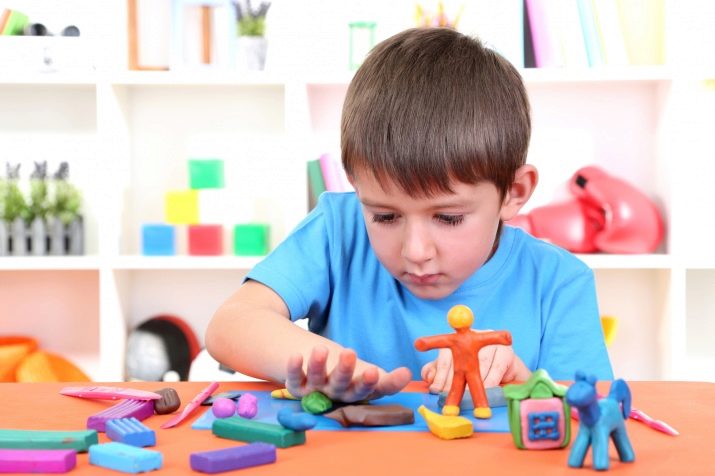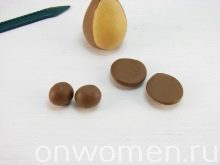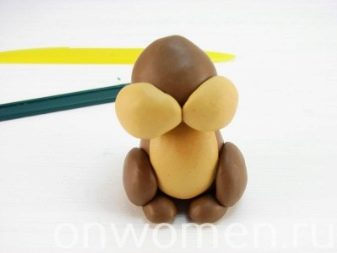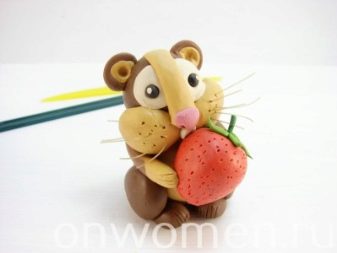We sculpt hamsters from plasticine

Little fluffy hamsters are considered one of the most popular pets. Therefore, children are happy to make figures of these cute animals from plasticine. Even preschoolers can cope with the creation of such a craft.



What is necessary?
Before you start sculpting a hamster, you need to prepare all the necessary tools and materials in suitable colors. Now there is a large selection of plasticine. You can choose any of them for work.
- Classical... The usual soft plasticine is made on the basis of clay powder and wax. It is painted in vibrant colors. Therefore, kids like crafts made from classic plasticine. This material is characterized by high softness and ductility. This means that it is very convenient to work with it. It is easy to create small details from such plasticine.

- Ball... This material is suitable for babies. It consists of a large number of balls, interconnected by dense glue threads. The advantage of this material is that it massages the fingers while working. In addition, crafts made from ball plasticine keep their shape perfectly. It is worth using this material to create the simplest crafts.

- Plant-based plasticine. This modern material is often bought for the little ones. It contains plant components, so it is completely harmless. In addition, such plasticine is much softer than usual. This means that it is easier to sculpt crafts from it.

- Pearl... This material with a slight pearlescent sheen looks especially impressive. It is suitable for creating both full-fledged crafts and individual parts.

To create figurines of hamsters, you can pick up any of these types of plasticine. High-quality material should not:
- dry quickly and crumble;
- contain harmful synthetic components;
- get your hands dirty with a greasy film;
- paint palms in bright acid colors;
- have a strong unpleasant odor.
In order not to stain the workplace in the process of creating crafts, it is worth using modeling board... It can be made of silicone or plastic. Such boards are good because plasticine does not stick to them, so it is convenient and easy to work on them.

You will need a neat stack to work with plasticine. It is used to form various grooves and reliefs on the finished craft. As a rule, the stack comes with a plasticine package, so you don't need to buy it separately.

Classic version
To create such a simple craft, you will need five colors of plasticine (white, gray, black, pink, yellow). The step-by-step sculpting process consists of the following steps.
- The first step is to separate a large piece from the bar of gray plasticine. It needs to be kneaded well.
- A slightly elongated ball should be formed from this material.
- Two short "sausages" should be molded from two small pieces of plasticine. They are attached to the body of the animal on the sides.
- Two more balls should be kneaded well and attached to the head in the form of small ears.
- A thin oval must be formed from a piece of white plasticine. It attaches to the front of the figurine.
- Two small balls of the same white plasticine must be attached to the hamster's face. Complement his eyes - two black pupils with tiny light specks in the center.
- Two lower legs need to be formed from pink plasticine. The third ball is attached to the animal's face.
- Subtle black details will complement the base of the figure. The strips are attached over the hamster's eyes and on his face.
- From the yellow mass, you need to mold several seeds of a suitable size. You can decorate them with a regular stack. One of the seeds is attached in the paws of the animal, the rest can be piled up next to it.

A simple craft for children is ready.
How to make a cute figurine?
The second version of the figure is more elaborate. The step-by-step process for creating crafts is as follows.
- From a set of plasticine, you need to choose bars of brown, green, beige, black, red and white.

- A large piece must be cut off from a large brown bar and kneaded well. From this material, you will need to form a drop-shaped workpiece. The body of the hamster will turn out to be even and neat.

- From a well-mashed piece of beige plasticine, you need to form an elongated cake. It is used to highlight the breast and belly of the animal. To make this part of the body look natural, the edges of the plasticine part should be well smoothed.


- After that, you can start forming the legs. From brown plasticine, you need to mold two neat balls and two elongated cakes. These parts are interconnected and attached to the sides of the sculpture. After that, the legs must be carefully drawn with a stack.



- To create the head, you need to roll a small brown ball and two smaller beige ones. Light cheeks are neatly attached to the sides of the head.


- From beige plasticine, you need to form a long strip and fix it on the upper part of the face. A neat pink nose will complement the muzzle.

- It is necessary to form two circles from soft white plasticine and attach them above the cheeks... The eyes need to be supplemented with black pupils. They can be made from plasticine or beads. Above the eyes with a stack, you can draw neat short eyelashes.

- The ears for the figurine are made of flat circles (brown and beige) connected to each other. They are attached to the very top of the head.

- The front legs of the animal are made from the same colors. The brown pieces are rolled into long sausages. They are complemented by small beige "gloves". They, like the lower legs, need to be carefully decorated with a stack.



- When the legs are attached to the upper body, you can start creating the decor... Form a strawberry of a suitable size from red plasticine. From green - a neat tail, consisting of leaves and a stalk. The strawberries need to be fixed in the hamster's paws and carefully decorated with a sharp toothpick.

- It should also be used to decorate the face of the animal. The mustache can be drawn with a stack or toothpick, or made from short pieces of sturdy fishing line.

- Two teeth need to be molded from white plasticine, which will give the craft a realism.


A cute figurine of a hamster with a strawberry is ready. This craft will appeal to both schoolchildren and adults.
Useful Tips
Children should start sculpting figures from plasticine from one and a half years old. Young children should only work with this material under the supervision of an adult. In addition, the clay itself must be of high quality and safe. Most often, parents buy wax plasticine on a natural basis for babies.

To make it malleable, you need to knead it well in your hands.
If the material is too hard and it is inconvenient for babies to work with it, it can be warmed up in warm water... It is very simple to do this - just put a piece of plasticine in a glass bowl or cup, which is then placed in a pot of hot water for a couple of minutes. After that, it will be easy to form a part of the desired shape from a large piece of plasticine.

The little hamster figurine can be supplemented with various natural materials. Acorns, cones, nuts or seeds are well suited for this purpose. They must be clean and well dried. Also, a composition with such an animal in the base can be supplemented with dry moss and stones.
Any child can create a beautiful plasticine figurine. The main thing is to approach the process with imagination and use only high-quality materials for work.


For information on how to mold a plasticine hamster, see below.








